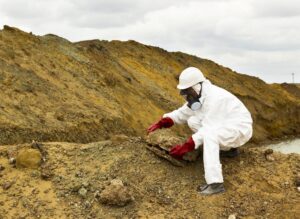On January 17, 2024, the EPA issued guidance that recommends lowering the screening levels used to investigate and clean up lead-contaminated soil in residential areas where children live and play.
The guidance, issued by the EPA Office of Land and Emergency Management (OLEM), marks the first time in 30 years the Agency has recommended lowering these screening levels. It’s effective immediately.
“EPA is lowering the screening level for lead in soil at residential properties from 400 parts per million (ppm) to 200 ppm,” an Agency news release says. “At residential properties with multiple sources of lead exposure, EPA will generally use 100 ppm as the screening level.”
The residential soil lead regional screening level (RSL) and regional removal management level (RML) are used in Comprehensive Environmental Response, Compensation, and Liability Act (CERCLA), commonly known as “Superfund,” remedial and removal programs, respectively, and the Resource Conservation and Recovery Act (RCRA) Corrective Action program.
“Every family and child, regardless of their zip code, deserves to live without worrying about the lifelong health effects from exposure to lead pollution,” said EPA Administrator Michael S. Regan in the Agency news release. “Today’s action ensures that EPA uses the latest, best available science to protect children living and playing near sites contaminated by lead in soil.”
“Screening levels are not cleanup standards,” the news release adds. “While this update will help EPA site teams make site-specific cleanup decisions to protect nearby communities, EPA makes cleanup decisions specific to each site, using site-specific factors, including risk factors and community input that can vary from site to site.”
Specific recommendations within the guidance issued by the OLEM include:
At the RSL:
- EPA regions should use a residential soil lead RSL of 200 ppm.
- However, EPA regions should use an RSL of 100 ppm if an additional source of lead is identified (e.g., lead water service lines, lead-based paint, nonattainment areas where the air lead concentrations exceed National Ambient Air Quality Standards (NAAQS)). The recommended RSL of 100 ppm considers aggregate lead exposure an increased risk to children living in communities with multiple sources of lead contamination. In making site-specific decisions on when to use an RSL of 100 ppm, EPA regions may use national data sets identified by the OLEM for this purpose. EPA regions may also use site-specific sources of information (e.g., data from the local health department or local public water system), alone or in combination with national data sets, to select an appropriate RSL of either 100 ppm or 200 ppm. EPA regions should document the site-specific rationale for the selected RSL.
- Federal-led RCRA corrective action residential soil lead cleanups should use an RSL of 200 ppm or 100 ppm based on the factors discussed above. The EPA strongly encourages states that are authorized for RCRA Corrective Action to use these RSLs in their state-led residential soil lead cleanups.
At the RML:
- EPA regions should use a residential soil lead RML of 200 ppm.
Industry takeaway
Of particular importance for industry to note is that the guidance states:
“This guidance should be considered for all residential lead sites subject to CERCLA response and RCRA Corrective Action authorities, including those previously addressed and/or deleted from the National Priorities List (NPL).”
This means, under this guidance, previously closed CERCLA and RCRA sites can be reevaluated and could require additional cleanup.
“The guidance suggests that under CERCLA, these evaluations can be done as part of the five-year review process, and under RCRA, post-remedy review authority allows the agency to reopen permits based on new information,” advises a National Law Review article by Bruce White of Barnes & Thornburg LLP. “For those who have already been down this road for emerging contaminants (e.g., 1,4 dioxane and PFAS), reopening closed sites has been a practical and financial nightmare. There is little more unsettling in the environmental arena than having to contact a group of potentially responsible parties (PRPs) who understood they had resolved their CERCLA liability at a site (and who may have settled with their insurers based on that belief) and telling them they may be facing substantial additional response costs to conduct further investigation and remediation.”
This approach is problematic because some PRPs are no longer in existence. Those that are still operating are forced to reopen past financial accounting records to make new shareholder disclosures, “and the PRP group’s original decades-old allocation may not apply to the contaminant giving rise to the reopening (and some of the PRPs may assert that they have no nexus to that contaminant),” says Barnes & Thornburg. “There also is a very real risk the agency will seek reopening for yet another contaminant in the future.”
For those companies that have received confirmation that a RCRA corrective action has been completed, the guidance is particularly unsettling.
“These potential risks highlight the renewed importance of reopener provisions in administrative orders and consent decrees,” Barnes & Thornburg advises. “While parties do not have the luxury of reforming reopener provisions in existing agreements with the EPA to conform to the evolving landscape, they do have the opportunity to take a fresh look at reopener provisions in new agreements going forward. Given the growing uncertainty about finality at CERCLA and RCRA sites, parties need to consider options for narrowing the scope of agency reopeners, particularly for the period immediately after the agency approves closure, for new information and unknown conditions.”
Although the OLEM guidance is immediately effective, interested parties are encouraged to comment on the guidance, as public comments may be considered for future updates. Comments will be accepted in the Federal eRulemaking platform under EPA Docket #: EPA-HQ-OLEM-2023-0644 until March 17, 2024.

